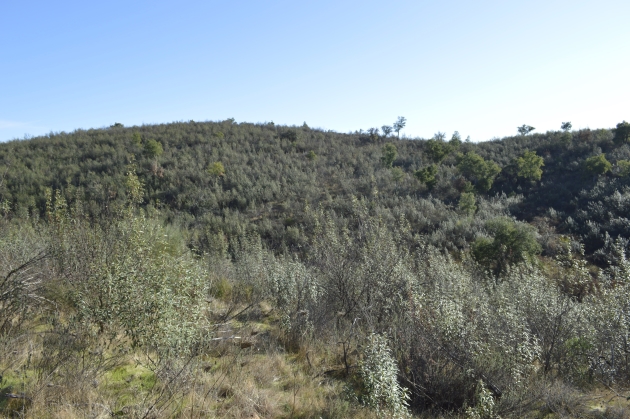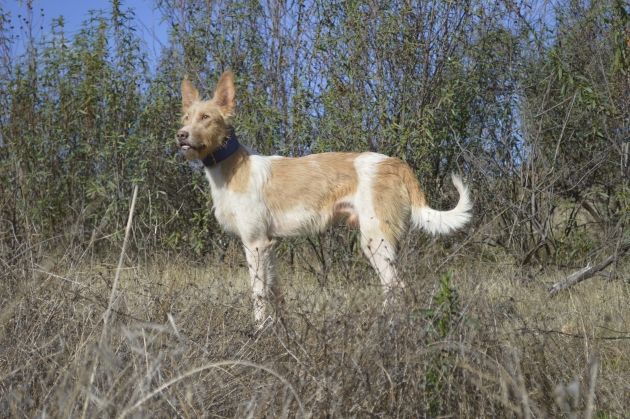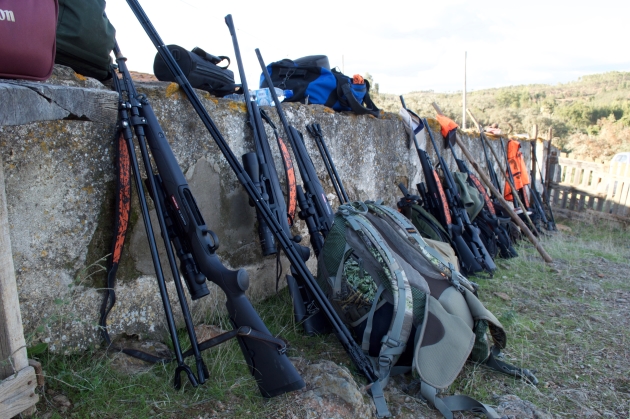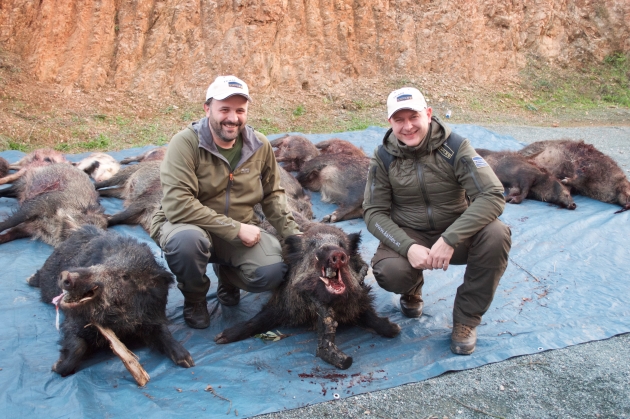After completing the first day of my monteria, a traditional European driven hunt, I felt like I knew what to expect going into the second day. After all, I was an old hand at this hunting style now, ready for any and everything. Right?
Hardly.
Our target species for the second day was wild boar, although a stray deer was possible. The second day’s terrain wasn’t quite as hilly as the first day’s, but the vegetation seemed to be 40 times more dense. Thickets head-high to a man were everywhere, and the bare patches of ground we had enjoyed the first day were completely absent. The area itself was almost as large as the day before, roughly 250 hectares in total.
We were again dropped off at our hunting positions around 10 a.m. This time there were no deer walking in the cool of the morning; no antlers hiding in the shade of a tree. This was Texas-thick scrub, and if there were boars around, I’d have to either smell or hear them, because there was no way I was going to see them.
I think, think, I heard a boar before the handlers let slip the dogs of monteria. My senses were straining so hard to penetrate the surrounding cover that I probably just imagined the low grunting of a giant pig, but whether I was right or wrong, I’ll never know. The noise ceased as quickly as it began, with a lengthy silence that followed between it and the beginning of the drive.

The author’s view on the second day of his monteria. Imagine shooting into this at something running full bore.
Once again, the sound of bells, yips, and handlers’ calls came roaring down the hillside to me. This time I was near the start of the drive, with my cut of the action beginning almost immediately. The boars began moving only when the dogs closed in, running through the brush with the pack right on their tails. In the dense growth of grass, bushes, and low-growing trees, paying attention to what body of fur was flying by was critical in order to avoid hitting a dog.
That’s how I lost out on the biggest hog I saw all day, maybe even the biggest anyone saw. A gigantic sow came bulldozing straight down the hill across from me, half a dozen dogs in pursuit. I held my fire to avoid hitting any of the dogs with a shot that fell behind the hog. I also hoped the hog would continue down the trail it was blazing and come directly at me, or just to one side.
Nothing doing. The hog hit an unseen riverbed below me and cut hard to the left, taking it away to my right without another glimpse. I was glad to have passed up the shot but a bit discouraged by the reports I heard from around the bend. No doubt some other hunter had claimed “my” pig.

The noble monteria dog, in all his glory.
I had a lot of time to ponder my untaken shot. A few more pigs passed me by, each unseen and barely heard. The only thing that allowed me to track their movements was a Jurassic Park-like bending of grass. For all I knew, a velociraptor was running around out there begging to be shot.
The drive moved past me not long after, leaving the hills quiet in my vicinity. The drivers would push the pack away from the trucks in the morning, get to the end of the hunting area, then swing back through toward the starting point at hunt’s end. They picked up hogs along the way that had laid low on the first pass and gave most every hunter one last shot opportunity before the dogs reached the finish line.
That’s the way my lone hog came along. He came screaming down the same hill the big sow had, but instead of coming straight down the hill, he cut longways across it with only two dogs in pursuit. The dogs were tired and lagged behind him, so both of my earlier problems were gone.
I had the Kahles Helia 5 turned to 3X, and with the hillside closer to me than the day before, the shot was perfect. The boar was running left to right across the middle of the hill, and I shot three times as he ran in and out of the thicker cover. The Merkel RX Helix’s straight bolt pull is the only reason I could crank off the shots fast enough, and if I hadn’t been shooting 179-grain .30-06 loads from Norma, I probably couldn’t have made it through the brush without deflecting off some unseen twig or branch.

Great equipment made the difference on this hunt. Without the quick handling of the Merkel RX Helix, the adaptability of the Kahles Helia 5 scope and the Dentler scope base, and the premium performance of the Norma ammunition, there’s no way we hunters could have made such successful shots.
I don’t know which one it was, but one of the three shots connected before the boar raced back over the hill. The dogs and our host, Paulo Pereira, found it just over the rise.
And that was it; my monteria was over. We gradually picked up the other hunters, many of which had at least seen hogs if not connected. Amazingly, the sow I had missed out on earlier had run the gauntlet and escaped two other hunters after me.
We held another closing ceremony for this hunt. This one was strictly for the animals, without anyone needing to be “baptized.”
One of the most unusual stories from the hunt was one of a boar shot by two hunters, Kahles’s Josef Kampfer and Polish hunter Lukasz Dzierzanowski. Kampfer had shot at the hog and assumed he had missed. The hog then ran by Dzierzanowski, who shot and killed it. When the animal was retrieved and laid out for the closing ceremony, everyone began noticing a tusk missing from the boar’s lower jaw. Kampfer hadn’t missed; he had shot off one of the boar’s teeth!
So ended my monteria. Between the traditions of the hunt itself and the camaraderie of my fellow hunters, it was one of the best hunts of my career—on any continent. The gear was perfectly tailored for both the animals and the terrain, bringing together features rarely found on the market.
But more on that later.
Be sure to check back for more articles on the gear and traditions of this Portuguese monteria.

